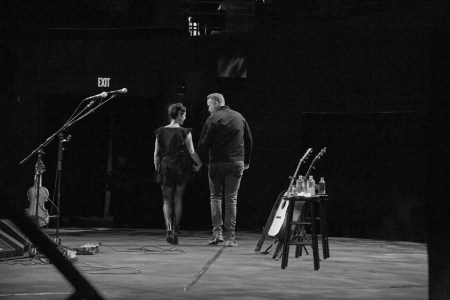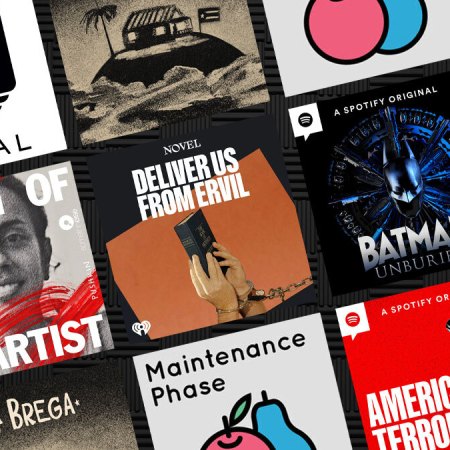When Rachel Brodsky, a Los Angeles-based cultural critic, decided to put together a podcast devoted to breaking down the most memorable uses of music in movies and TV shows, she knew she had to pick the brain of her downstairs neighbor, Aviv Rubinstien. Rubinstien is a filmmaker, musician and podcaster, and she knew she’d want his expertise on how to get the idea off the ground. She asked him to meet for coffee at their local cafe, and she left with a co-host.
“I was unsuccessfully trying to play it so cool because I didn’t wanna be like, ‘Please let me co-host the show with you,’” Rubinstien tells InsideHook about that meeting. “But I think by the end we wound up sitting in that cafe for like 90 minutes and coming up with the first 10 episodes. It started with like, ‘I can help kind of give you best practices. Well, I can probably engineer the show for you ’cause I’m your downstairs neighbor. Well, if you need a co-host…’ I was trying to play cool and it didn’t really work, but it worked out for me in the end.”
It certainly did work out: *IN SYNC, the duo’s podcast delving into pop culture’s finest needle drops, launches today (April 11) via Gotham West Studios. (You can find it and subscribe wherever you get your podcasts.) Each episode is devoted to a single song used in a film or TV show, and Brodsky and Rubinstien are joined by guests like music supervisors Rob Lowry, Gary Calamar and Thomas Golubic and Jordan Ross Schindler, the creator of Cruel Intentions the Musical. Their first episode examines a classic onscreen needle drop, the use of Sia’s “Breathe Me” in the final scene of HBO’s Six Feet Under, and subsequent installments tackle memorable musical moments from Empire Records, Wednesday, The Last of Us, Cruel Intentions and Do Revenge.
For Brodsky, it was important that the podcast mix in a healthy amount of contemporary examples. Streaming — whether it’s music or other content we’re consuming — has made it much more difficult to achieve a water-cooler moment these days, so when music used in a show is able to find its way into the zeitgeist the way, say, Kate Bush’s “Running Up That Hill” did with Stranger Things, it’s all the more special. That, she says, is what makes for a great needle drop.
“For me personally, it’s like, is this grabbing my attention in a way that everything else just kind of falls to the side? And then second, you start to see that song in question fan out to other platforms,” Brodsky explains. “Or what was the audience’s reaction? Because if I’m feeling moved, chances are other people are feeling moved too. And is this song popping up on TikTok? Are people taking the song and kind of making it their own, in their own videos, their own soundtracks? Are we seeing a bump in streaming? Are we seeing a Billboard charting reaction? And so there’s the emotional and then there’s the actual hard numbers. And then once an audience has a chance to respond, are they feeling something? And then the third element is, is the song having this afterlife that you would maybe have not expected thanks to its placement?”
Of course, simply running through a list of great music placements in film doesn’t necessarily make for great listening, and as Rubinstien points out, he and Brodsky are constantly looking for broader themes to address and additional context to provide to really offer a deep dive into a particular musical moment.
“Running With Our Eyes Closed” Is More Marriage Doc Than Music Doc
The marriage between Jason Isbell and Amanda Shires is the heart and soul of director Sam Jones’s latest film“I think the most important thing, or one of the kind of secret keys to what this show is, is we try to figure out what about the song makes the needle drop special and connects,” he says. “So I’ll give you an example of one of our episodes is about The Last of Us needle drop for ‘Long, Long Time.’ And we discovered, kind of through our research, that both Linda Ronstadt and the showrunner of The Last of Us, Craig Mazin, and the characters within The Last of Us, all three of them are stories of reinvention. And so that’s what our show is about, about finding yourself in reinvention despite what box people may put you in. I think we both cried on the episode, but the fact that we were able to figure out the overall theme or meaning behind the show, the song and the episode made it really special.”
Ultimately, he and Brodsky are both huge fans of both music and the moving image, and they hope to be able to shine more of a light on the talented people responsible for finding the perfect song for a particular onscreen moment — who don’t often have the same name recognition as the directors whose work they’re elevating.
“I’m always surprised to see the versatility of a lot of these music supervisors,” Rubinstien says. “We have this idea of auteurs where Quentin Tarantino only makes Quentin Tarantino movies and uses Quentin Tarantino songs to make Quentin Tarantino movies. And the people who are professional music supervisors have such a breadth of knowledge and can drop into any type of story and say, ‘Ah, I know the rare 1970s punk track or the underground French rap or the whatever that is perfect for this moment.’ And it is like being a human music encyclopedia for all genres, but also with this emotional component of like, ‘I know the emotion.’ It’s like being a therapist and an encyclopedia, where I know the moment that you, the filmmakers, are trying to get across to the audience, and I saw some band in a basement in Croatia that can give you this moment. And that’s a superpower to me. I don’t understand it.”
“That’s what the true gift is with music supervision, finding the song in your mental Rolodex or in your literal physical Rolodex that feels perfect yet surprising and then becomes superglued to this moment,” he continues. “So that every time I hear the Shins song ‘New Slang,’ I close my eyes and I think of Natalie Portman’s face in Garden State, a movie that I no longer particularly like. But because that sync is so strong, I can’t separate them anymore.”
The pair keeps a giant master list of music syncs they’re considering devoting future episodes to, and they’re constantly updating it with suggestions from friends and family who are already eager to hear the two hosts break down their personal favorites.
“This is just a chance to talk about music and screen time, which are my two favorite things, but the level of like, ‘Ooh, let’s talk about it, and dude, make sure you do an episode on The Americans and make sure you do an episode of this,’ a lot of people in my inner and outer circles have been like, ‘I’ve got an idea, you should do this,’” Brodsky says. “And that’s been very validating and makes me more excited. Just to hear that anyone is excited to join in the conversation with us, that just makes my whole life.”
This article was featured in the InsideHook newsletter. Sign up now.



















![[L-R] Bill Berry, Michael Stipe, Mike Mills and Peter Buck of R.E.M. at the Aragon Ballroom in Chicago, Illinois on July 7, 1984.](https://www.insidehook.com/wp-content/uploads/2024/12/rem-book-interview.jpg?resize=750%2C750)




